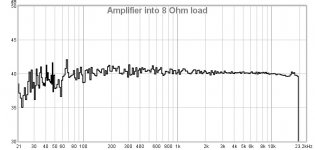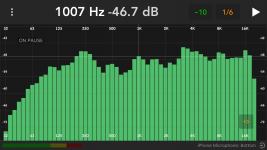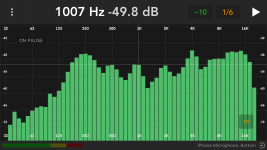I've found many a good speaker at such places - including Tannoys, JBLs, LS3/5As and Klipsch (with blown tweeter in one). None of which I could afford to keep! The ebay prices of those early Pioneer and Sansui 15s!
Yet sometimes I'm reluctant to drag home another piece of junk, particularly if I'm not sure of its functionality. Many times, hunting for a 9V battery and a couple pieces of wire for a "click test" - I've got something better!
Start with a $5 amplifier off ebay;
MP3 USB Flash Drive Micro SD TF Card Player Decoding Amplifier Board Module USA | eBay
...that happens to be able to play .mp3s from a microSD card. Load the card with one of those "15 minutes of pink noise" files. Put that with a portable 5V phone recharger with two 18650 batteries inside from Costco. With a couple of clip leads attached, there's a portable electronic noise source in a zip up case.
By ear. If / when you get good at it, you can tell if something's right simply by listening to the candidate speaker.
If you really want to get technical, there's many an app for your phone which can do the listening for you - and present the results in real time on a nth octave display. I paid $15 for mine, the "spectrum-eye" running on my iPhone 6.
The first graph shown is the amplifier output spectrum, taken using REW with a TASCAM US-122L ADC across an 8 Ohm, non inductive resistor. Not bad for a $5 amp and certainly suitable for initial assessment purposes. The plots in green are the spectrum-eye display, showing how a couple different junk speakers I have laying about sound different. These were measured outdoors.
It's not a stretch to find a pair of KEFs (multiple times...) at some yard sale, wonder if they are OK - and go fetch this thing from the car glovebox. Easy, peasy yay-or-nay data point to help decide. I've seen some sets where the seller was just asking too much, for the risk of trusting a "they work" claim.
Yet sometimes I'm reluctant to drag home another piece of junk, particularly if I'm not sure of its functionality. Many times, hunting for a 9V battery and a couple pieces of wire for a "click test" - I've got something better!
Start with a $5 amplifier off ebay;
MP3 USB Flash Drive Micro SD TF Card Player Decoding Amplifier Board Module USA | eBay
...that happens to be able to play .mp3s from a microSD card. Load the card with one of those "15 minutes of pink noise" files. Put that with a portable 5V phone recharger with two 18650 batteries inside from Costco. With a couple of clip leads attached, there's a portable electronic noise source in a zip up case.
By ear. If / when you get good at it, you can tell if something's right simply by listening to the candidate speaker.
If you really want to get technical, there's many an app for your phone which can do the listening for you - and present the results in real time on a nth octave display. I paid $15 for mine, the "spectrum-eye" running on my iPhone 6.
The first graph shown is the amplifier output spectrum, taken using REW with a TASCAM US-122L ADC across an 8 Ohm, non inductive resistor. Not bad for a $5 amp and certainly suitable for initial assessment purposes. The plots in green are the spectrum-eye display, showing how a couple different junk speakers I have laying about sound different. These were measured outdoors.
It's not a stretch to find a pair of KEFs (multiple times...) at some yard sale, wonder if they are OK - and go fetch this thing from the car glovebox. Easy, peasy yay-or-nay data point to help decide. I've seen some sets where the seller was just asking too much, for the risk of trusting a "they work" claim.
Attachments
Last edited:
This is a fantastic idea, thanks Joe!
Where does the app on your phone get it's audio input? Is it just using the phone's mic or an external? If the internal phone mic, would you consider this good enough only for 'quick and dirty' evaluations such as you're outlining here, or would this basic setup be usable for more "real" comparisons between drivers?
Those graphs you show, are they both listening to that pink noise, or some other signal?
Where does the app on your phone get it's audio input? Is it just using the phone's mic or an external? If the internal phone mic, would you consider this good enough only for 'quick and dirty' evaluations such as you're outlining here, or would this basic setup be usable for more "real" comparisons between drivers?
Those graphs you show, are they both listening to that pink noise, or some other signal?
@Elmojo - thanks, the app gets its input from the phone mic. Apparently there are more than one mic available on the iPhone 6, but I've only used the same one every time. The app says it can defeat whatever EQ Apple put in place for a better measurement response. The two green graphs are a couple different speakers response to the pink noise, driven by the portable amplifier setup.
Of course the idea works using REW / PC / Calibrated mic, so the basic setup will work for more "stringent" analysis. I presented the idea using the phone because;
1. It's usually with me when I go out of the house
2. Who wants to drag around a PC, ADC and Mic on the off chance you stumble upon something worth investigating?
I had a friend bring over a speaker he'd constructed many years ago. It had 5, 6" drivers and some bullet tweeter, a Dayton crossover that he'd always set the level control midway. Measuring, you could immediately see the tweeter's output was a shelf like 20 db above the lower frequencies; just barely cracking the level from all the way off made it flat with the rest of the output. He said he had no idea it did this...
I imagine with REW and a good mic - or ADC connected directly to a crossover output - this technique could reveal a lot about a design.
Of course the idea works using REW / PC / Calibrated mic, so the basic setup will work for more "stringent" analysis. I presented the idea using the phone because;
1. It's usually with me when I go out of the house
2. Who wants to drag around a PC, ADC and Mic on the off chance you stumble upon something worth investigating?
I had a friend bring over a speaker he'd constructed many years ago. It had 5, 6" drivers and some bullet tweeter, a Dayton crossover that he'd always set the level control midway. Measuring, you could immediately see the tweeter's output was a shelf like 20 db above the lower frequencies; just barely cracking the level from all the way off made it flat with the rest of the output. He said he had no idea it did this...
I imagine with REW and a good mic - or ADC connected directly to a crossover output - this technique could reveal a lot about a design.



